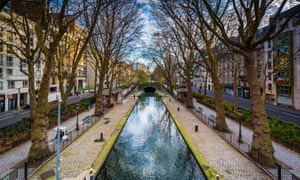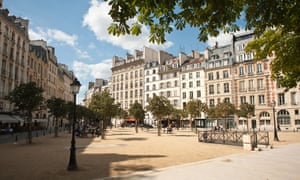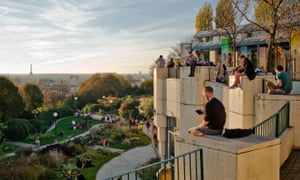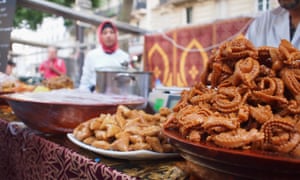Tom Downey goes in search of the French capital’s landmarks – as patrolled by Georges Simenon’s French detective

By rights Le Bar du Caveau, on the Ile de la Cité’s Place Dauphine, one of the most picturesque squares in the very centre of the tourist’s Paris, should have been crammed with foreigners. Instead, at lunch hour, the only time it was open, it was filled with lawyers from the adjoining Palais de Justice who clearly hadn’t got to talk enough in court because they were now screaming their heads off.
I asked, politely and in French, if a female lawyer sitting to my left wanted to switch places with me so she could more easily converse with the man sitting to my right. “No,” she said and then continued to shout in my ear to communicate with her colleague. The perfectly creamy, soft-scrambled eggs piled on to crisp brown bread were partial consolation.
I thought of Georges Simenon’s curmudgeonly, phlegmatic detective, Chief Inspector Maigret. Not only was the bar adjacent to his fictional workplace at the Police Judiciaire, but this kind of bar – tiny, timeworn and populated almost entirely by customers of the same profession who knew each other well – was precisely the kind of environment Maigret sought out in order to solve a crime. If there was a Maigret methodology, then perhaps its most axiomatic lesson was this: exit the scene of the crime as soon as possible. Scan the street corner for an adjacent bar or bistro. Mozy up to the counter and have what they’re having. Wait, listen and observe. Have some more of what they’re having.

Simenon published his 75 Maigret novels and 28 Maigret short stories between 1931 and 1972; last month ITV broadcast the first of two made-for-TV Maigretmovies starring Rowan Atkinson as the chief inspector. And so I set off to do a little detective work of my own, to discover whether Maigret’s Paris, full of squalid, storied hotels with communal bathrooms, apartment buildings with nosy concierges and, most importantly, characterful regional bistros and hyper-provincial bars, could still be found.
I made a list of Maigret’s haunts: 32 Quai des Orfèvres, where he worked; 132 Boulevard Richard-Lenoir, where he lived with Madame Maigret; the Brasserie Dauphine, where he ordered trayfuls of beer and sandwiches when he was working late and which, according to some, was based on the Restaurant aux Trois Marches on the Rue de Harlay. But Maigret’s Paris wasn’t a physical landscape as much as an emotional, psychological and anthropological one. Take a walk through Paris with a Simenon policier and you will find the echoes and shouts, the smells and stenches dissected historically, thematically, philosophically. I decided to plunge into the dark alleyways of Paris with only a copy of Simenon’s Two Penny Bar, and see where it took me. The problem, in today’s Paris, was finding any dark alleyways at all.
I was staying at the Le Robinet d’Or, just east of the Gare de l’Est and Gare du Nord train stations and a few steps west of Canal Saint-Martin. Maigret loved the atmosphere of train stations. He also frequently patrolled the small streets flanking the canal, home back then, to dozens of residential hotels and colourful regional bistros run by people from the north and east of France. They’d disembarked from the railway and not get very far before opening hotels, restaurants or bars catering to their fellow transplants.

The immediate neighbourhood around the canal is now so thoroughly hipsterised that Maigret, finely attuned to the distinctions between petite and haute bourgeoisie, would probably have to quickly down a few strong marcs before he could process the idea of wealthy young Parisians deliberately embracing, en masse, an area that was once so working class.
A few minutes walk away, though, just opposite the Gare de l’Est, I found Schmid Traiteur, an Alsatian delicatessen here since 1904, and joined a crowd of commuters at some small tables sampling the tarte flambée, the sausages and the sauerkraut. One feature of Maigret’s Paris was that it was a city not just of immigrants from eastern, central and northern Europe, but also that it was filled with French people from other parts of the country. They brought with them their regional cuisine, their local wines and their strange-sounding dialects, peppering Parisian street corners with the exotic herbs of Provence or the sweet yet acidic wines of Alsace. I washed down my meal with a glass of Alsatian riesling and thought about how Maigret’s Paris is now being reimagined.
In Maigret Sets a Trap, Rowan Atkinson tried to adhere to the quirks of the original character: constant pipe smoking, an unshakeable and prescient demeanour, a thoroughly domesticised home life in contrast to a work life hunting killers and criminals. But the real problem with the ITV drama isn’t performance or plot. It’s Paris. Shot on soundstages or in the streets of Budapest, the TV series offers us only fleeting, artificial glimpses of the city.

The Maigret novels aren’t about a dramatic revelation of whodunnit – they are about process. And Maigret’s process means poking around: strolling the boulevards with a lit pipe in hand, ducking in and out of neighbourhoods to feel the pulse of a place at dawn and dusk, sampling a herring fillet or a home-style cassoulet at a local cafe. This process, come to think of it, is exactly how I love to explore a city – minus the pipe, plus a bicycle.
I took to the streets on my Vélib. Though the city’s core is mostly for outsiders or the globalised rich, a short bike ride from Le Robinet D’Or plunged me into a very different Paris. There were rows of Turkish tailors and African braiding salons on Rue du Château d’Eau; Orthodox Jewish women in long skirts and wigs pushing prams along Rue Tristan Tzara; Congolese customers bargaining for fresh fish at the street markets of Château Rouge. Working class people from all over the city thronged the streets around Barbès-Rochechouart in search of quality clothes at good prices. Pockets of immigrant Paris remain, especially on this side of the Seine, as an antidote to the now sterile city centre.
Later that afternoon, I ventured east to Belleville, a neighbourhood now known for its unusual immigrant combinations – mainland Chinese, Sephardic Jews, North African Muslims, all jammed into one tiny quartier – and I stopped for a coffee at the counter of La Vielleuse, a giant cafe/restaurant with small tables spilling out on to terraces on the street. I sipped my café crème and gazed at the hundreds of people downing frothy beers, dipping crispy fries into mayonnaise and talking to each other in a friendly, conspiratorial, utterly Parisian way.
I did as I imagined Maigret would have, switching my coffee to a draft beer and ordering a small plate of oeufs mayonnaise to go with it. After a bite of boiled egg, and another look around, I realised something: though Maigret would have been baffled by the sound of Khmer, the sight of bearded men in cloaks, the text messages being sent off in Mandarin, all in such a thoroughly French establishment, he would have recognised and understood the relentless, complex energy of this place and the way that these relative newcomers had become so comfortable in this locale, just as the Poles and Burgundians, the Russians and the Alsatians all had in his Paris.


















